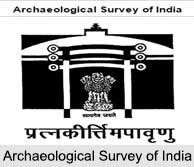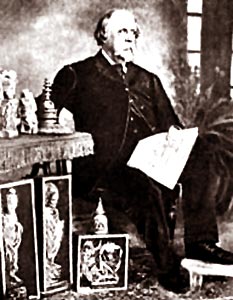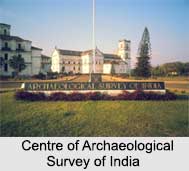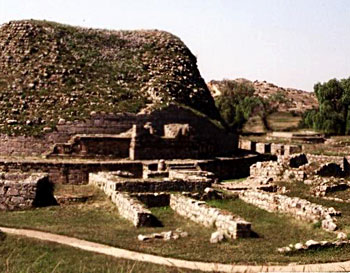Introduction
 Archaeological Survey of India or the ASI serves as one of the best sources of Indian History. It is an agency in the Government of India belonging to the Department of Culture. The organisation is responsible for archaeological studies and the preservation of cultural monuments in India. Archaeological Survey of India is responsible to preserve and protect the monuments which are of National and International Importance. The organisation falls under the Ministry of Culture.
Archaeological Survey of India or the ASI serves as one of the best sources of Indian History. It is an agency in the Government of India belonging to the Department of Culture. The organisation is responsible for archaeological studies and the preservation of cultural monuments in India. Archaeological Survey of India is responsible to preserve and protect the monuments which are of National and International Importance. The organisation falls under the Ministry of Culture.
Archaeological Survey of India at present administers 3636 monuments and it has been declared to be a national importance and it falls under the provisions of the Antiquity and Art Treasure Act 1972.
History of Archaeological Survey of India
 History of Archaeological Survey of India (ASI) has witnessed able administration starting from Sir Alexander Cunningham. It was set up in order to protect India`s ancient and medieval monuments and art objects of archaeological, historical interests. The exploration and excavation of ancient sites; the discovery and decryption of inscriptions; establishment and maintenance of site museums come under their purview. Even the maintenance of archaeological gardens around monuments, archaeological sites and remains; the chemical preservation of monuments and antiquities; the promotion of specialized studies in various branches of archaeology is a part of their responsibility. The architectural survey of secular and religious buildings; studies on different aspects of archaeology both in India and abroad; and publication of authoritative literature also come under the purview of this organization.
History of Archaeological Survey of India (ASI) has witnessed able administration starting from Sir Alexander Cunningham. It was set up in order to protect India`s ancient and medieval monuments and art objects of archaeological, historical interests. The exploration and excavation of ancient sites; the discovery and decryption of inscriptions; establishment and maintenance of site museums come under their purview. Even the maintenance of archaeological gardens around monuments, archaeological sites and remains; the chemical preservation of monuments and antiquities; the promotion of specialized studies in various branches of archaeology is a part of their responsibility. The architectural survey of secular and religious buildings; studies on different aspects of archaeology both in India and abroad; and publication of authoritative literature also come under the purview of this organization.
Archaeology as a subject of scientific study began only in the 1840s. The Industrial revolution had given a great boost to the study of field geology and archaeology. The establishment of ASI was preceded by the Asiatic Society. In November 1861, Alexander Cunningham, a Colonel of the Royal Engineers had addressed a long message to Canning thereby pleading him to institute a careful and systematic investigation of the existing monuments of ancient India through a professional organization. On 1st December 1861 Alexander Cunningham was appointed as the Archaeological Surveyor that marked the birth of this organization. Cunningham was succeeded by James Burgess whose efforts led to passing of Government directives prohibiting any person or agency to undertake digging without consent of the ASI.
The appointment of Lord Curzon as the Viceroy of India marked a new era in ASI. The performance of the Ancient Monuments Preservation Act, 1904, is a milestone in the history of archaeology in India. Immense volume of work was accomplished by the ASI during the tenure of John Marshall as it had made huge contribution in the field of excavation.
Marshall was also accountable for setting up a number of museums including site museums at Taxila, Mohenjo-Daro, Harappa, Sarnath, Nalanda and pagan. He was involved in establishing Central Archaeological Library; the initiation of the Annual Reports of the Archaeological Survey of India and of the chronicle of the officers; documentation of photographs; written by ASI officers.
The first Indian to occupy this position was Daya Ram Sahni in 1931. In 1944 Mortimer Wheeler was appointed who centralized the conservation work which was to be carried out by the Survey itself. In 1945, a Central Advisory Board of Archaeology for the purpose of reviewing and advising the Central Government in Archaeological matters was established. Post Indian Independence opened the School of Archaeology.
Aims and Objectives of Archaeological Survey of India
Archaeological Survey of India is designed to preserve and maintain the ancient monuments, archaeological sites and remains of national importance. The works and mission of Archaeological Survey of India is divided into 29 circles within the whole country. The organisation carries out its work through its Circles, Museums, Excavation Branches, Prehistory Branch, Epigraphy Branches, Science Branch, Horticulture Branch, Building Survey Project, Temple Survey Projects and Underwater Archaeology Wing.
Archaeological Survey of India manages more than 3650 ancient monuments, archaeological sites and remains of national significance. These can include everything from temples, mosques, churches, tombs, and cemeteries to palaces, forts, step-wells, and rock-cut caves. The organisation also preserves ancient mounds and other similar sites which symbolize the remains of ancient surroundings.
 Archaeological Survey of India is headed by a Director General who is helped by an Additional Director General, two Joint Directors General and 17 Directors. It protects a Central Archaeological Library in the National Archives building in "Janpath", New Delhi established in 1902. The Survey in addition maintains a library in each of its circles to cater to local academics and researchers.
Archaeological Survey of India is headed by a Director General who is helped by an Additional Director General, two Joint Directors General and 17 Directors. It protects a Central Archaeological Library in the National Archives building in "Janpath", New Delhi established in 1902. The Survey in addition maintains a library in each of its circles to cater to local academics and researchers.
Archaeological Survey of India provides evidences of the early Historic Period. Monuments and sites like Taj Mahal, Tomb at Sikandara, Qutb Minar, Sanchi and Mathura received nominal funds during the 19th century. The important sites excavated by the ASI include Harsha-ka-Tila at Thanesar in Haryana exposing a cultural sequence from the Kushan period to medieval periods.
Significance of Archaeological Survey of India
 Development through creation of specialized Branches: Excavations, Prehistory, Building Survey, Temple Survey, Epigraphy, Museums, Conservation, Science, Horticulture and Publication have added to the significance of Archaeological Survey of India. Institute of Archaeology offers a full-time Postgraduate diploma in Archaeology of twenty four months duration and several other specialized courses. The ASI is a multi-cadre organization who has archaeologists, civil engineers, chemists, epigraphists, horticulturists and administrators.
Development through creation of specialized Branches: Excavations, Prehistory, Building Survey, Temple Survey, Epigraphy, Museums, Conservation, Science, Horticulture and Publication have added to the significance of Archaeological Survey of India. Institute of Archaeology offers a full-time Postgraduate diploma in Archaeology of twenty four months duration and several other specialized courses. The ASI is a multi-cadre organization who has archaeologists, civil engineers, chemists, epigraphists, horticulturists and administrators.
Functions of the Archaeological Survey of India
The principal functions include conservation, developing and maintaining archaeological gardens, chemical preservation of monuments and antiquities; archaeological examination and excavations. Recording and editing of inscriptions; establishment and maintenance of Site Museums; promotion of specialized studies; architectural survey, publication of guidebooks on monuments, archaeological sites and remains, excavation reports, monographs on architectural studies are the other responsibilities of ASI.
Implementation of the Antiquities and Art Treasures Act (1972) is also a function of ASI. This is done in order to regulate export trade in artefacts and art treasures as well as to prevent smuggling and fake dealings in antiquities. Preserving antiquities in the form of sculptures is also one of its major functions. The protected list includes: forts, fortresses, palaces; temples, churches, mosques, monasteries, agiaris, synagogues, funerary monuments, palaces commemorating or connected with some important historical event; residential buildings, man-made reservoirs, tanks, step-wells and prehistoric sites.
This variety of protection lists does not allow any identical method of conservation that can be applied. The original personality of a monument has to be preserved by ASI. No new constructions that would materially alter the relations of mass and colour should be permitted. The moving of a monument cannot be allowed. Other functions include
ASI has also undertaken major conservation works abroad besides carrying out excavations, explorations, images and other studies in countries like Afghanistan, Nepal, Cambodia and Egypt. A museum was set up in Angola with the help of ASI. Other functions of ASI include architectural survey of monuments; conducting epigraphical and numismatic studies; imparting training in Archaeology and conducting horticulture operations in and around ancient monuments and sites.
Underwater Archaeology Wing
Underwater Archaeology cannot be avoided in a country like India that has a long coastline, many islands. The water areas of India are rich in underwater cultural heritage.
Underwater archaeology was started in the year 1981. Off shore explorations have been quite popular. However Underwater Archaeology Wing was established in the year 2001 that marked a major step towards the development in this regard.
Extensive archeological studies have been conducted in the Arabian Sea and Bay of Bengal. This department is dedicated to recording of underwater sites and old shipwrecks and protecting underwater cultural heritage. This wing collaborates with other government organizations for the study and protection of underwater cultural heritage.
Regulation of underwater activities is also one of the main concerns of this department.
Circles of Archaeological Survey of India<
The Archaeological Survey of India is divided into a total of 29 circles, each headed by a Superintending Archaeologist. Each of the circles is further divided into sub-circles. The circles of the Archaeological Survey of India are:
Agra
Aizawl
Amravati
Aurangabad
Bengaluru
Bhopal
Bhubaneswar
Chandigarh
Chennai
Dehra Dun
Delhi
Dharwad
Goa
Guwahati
Hyderabad
Jaipur
Jodhpur
Kolkata
Lucknow
Mumbai
Nagpur
Patna
Raipur
Ranchi
Sarnath
Shimla
Srinagar
Thrissur
Vadodara
The ASI also administers three "mini-circles" at Delhi, Leh and Hampi. Archaeological Survey of India is the leading organization for the archaeological researches and protection of the cultural heritage of the nation.



















